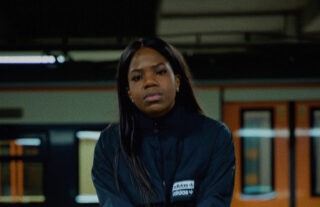Here’s the lowdown on ESNS Eurosonic Noorderslag and ESNS Exchange 2022
Who to catch at this year's virtual festival, and why it matters

Who to catch at this year's virtual festival, and why it matters
Since the 1980s, Eurosonic Noorderslag (ESNS) has provided an essential platform for emerging European musical talent. Over 30 years on, it’s just as important as ever – so here’s a Q&A explaining why.
ESNS Exchange – what’s that?
A partner program to the ESNS, the European Talent Exchange Program (or ETEP for short) is a mission to create live opportunities for European artists, both on the continent and further afield. For nearly twenty years, the initiative has raised the profiles and kickstarted the careers of a whole host of up-and-coming artists.
Okay, sounds good. What’s the ESNS, then?
ESNS (also known as Eurosonic Noorderslag) is an annual four-day showcase of new music, and one of Europe’s most important music conferences. Usually held in Groningen, Netherlands, but running online for the past couple of years due to the pandemic, it has become a bit of a bellwether event, connecting artists and bookers together and helping emerging acts find a larger platform for their music.
So, how does it work?
Think of the ESNS Exchange as a draft system for Europe’s music scene. Usually, the artists picked by the scheme perform live in front of promoters and festival bookers, which includes the likes of The Great Escape and Glastonbury, as well as events further afield such as Coachella in the US and Clockenflap Festival in Hong Kong. These bookers, in turn, receive incentives from ESNS to book the acts, meaning that emerging artists get access to a platform that can reach millions. Put simply: each January new musicians from all over Europe head to Eurosonic, which is attended by bookers from all over the world. Those bookers then book the artists they like for their own festivals and receive a fee for doing so from ESNS Exchange, encouraging them to support new musicians.
Even with COVID-19 raging, the initiative has been able to adapt and offer new artists a platform. Last year, festivals were encouraged to promote ESNS Exchange artists on their digital channels. This results in over a hundred different artists from 31 European countries having access to bookings and promotions during the pandemic – a vital lifeline when the rest of DIY music had ground to a standstill.
That all sounds great, but why does it matter?
Honestly, the impact of the ESNS Exchange is impressive. In the twenty years since the program’s start, the initiative has boosted the careers of a veritable who’s who of European pop, from Calvin Harris, Black Midi and Christine and the Queens to Dua Lipa, MØ and Shame. Just last year the program promoted the likes of Altin Gün, Black Country, New Road, Faux Real and Arlo Parks.
If cold, hard numbers are more your bag, you might like to know that over the past two decades, the ESNS Exchange has been directly responsible for 4,000 shows by 1,600 acts in 38 countries – making it one of the most successful EU cultural programs ever.
Facts on the ground all point to Brexit being a particularly devastating and prolonged skip fire for British music. What’s more, new acts have taken the brunt of it. Factoring in the increased cost of work visas, new import/export regulations and decreased access to support networks, it’s becoming increasingly unviable for small UK artists to play in Europe.
At the moment, ESNS Exchange is one of the few ways UK acts can still collaborate with European promoters, and the ESNS Exchange provides a vital leg up for acts looking to break on the continent.
Alright – when is it then?
ESNS is currently in prep mode and, thanks to the new Omicron variant, will be taking place entirely online. From 19-22 January 2022, next year’s event will focus on Spain and feature sets from a host of hotly-tipped favourites, including Bob Vylan, Alewya, Wet Leg and Mimi Webb.
ENNY (pictured up top)
Born and raised in Thamesmead, South East London, ENNY is a rapper and singer specialising in soulful, lucid tales of London life. A long time collaborator with Root 73, an artist development program run out of Hackney, her 2020 hit ‘Peng Black Girls’, featuring her label boss Jorja Smith was a surprise viral hit and has cemented her reputation as one of the capital’s most exciting young talents.

The alter ego of Dubliner David Balfe, For Those I Love has been responsible for one of the most remarkable records of recent times. A tribute to a friend and bandmate who has passed on, the music is a collage of old WhatsApp voice notes, poetry and dance samples intertwined with Balfe’s spoken-word storytelling.

The brainchild of Belgian singer Joachim Liebens, The Haunted Youth is a Hasselt-based indie outfit making shimmering, hypnotic pop along the lines of MGMT, Slowdive and DIIV. Juxtaposing lyrics soaked in loss, heartache and typical teenage ennui with richly layered dream pop, it’s the perfect music for misfits.

Pódium is a straight-out party act from Spain, which sport a sound that’s actually a little hard to pin down. Originally a vehicle for the drum machine and guitar styles of band leader Nick Trampolino, the project’s since grown into a fully-fledged five-piece pumping out psychedelic rock that veers between hardcore, industrial metal, and the odd surf guitar solo.

Ditching the hecticness of Paris for the relative calm of the French Countryside, Irène Drésel has perfected a hypnogogic version of techno that mashes sensual melodies and bold textures into something exceptional. With a handful of EPs and one full-length album in the bank, she’s fast establishing herself as one of Europe’s most exciting new dance acts.

A New Yorker adrift in Berlin, Discovery Zone is the umbrella term for JJ Weihl, who uses video collage, PowerPoint and algorithmic art to make what can only be described as super weird pop music. A musician and multi-media artist who’s also a founder of experimental pop project Fenster, her experiments explore the lines between human experience and cyberspace.

An experimental pop act from Denmark, Hôy La’s sound is probably best described as a highly esoteric melding of jazz, grime and experimental pop. Releasing their first album There’s a Girl In My Brain Who Wants to Die back in October, the trio make smouldering trip-job infused jams that manage to sound like nothing else.